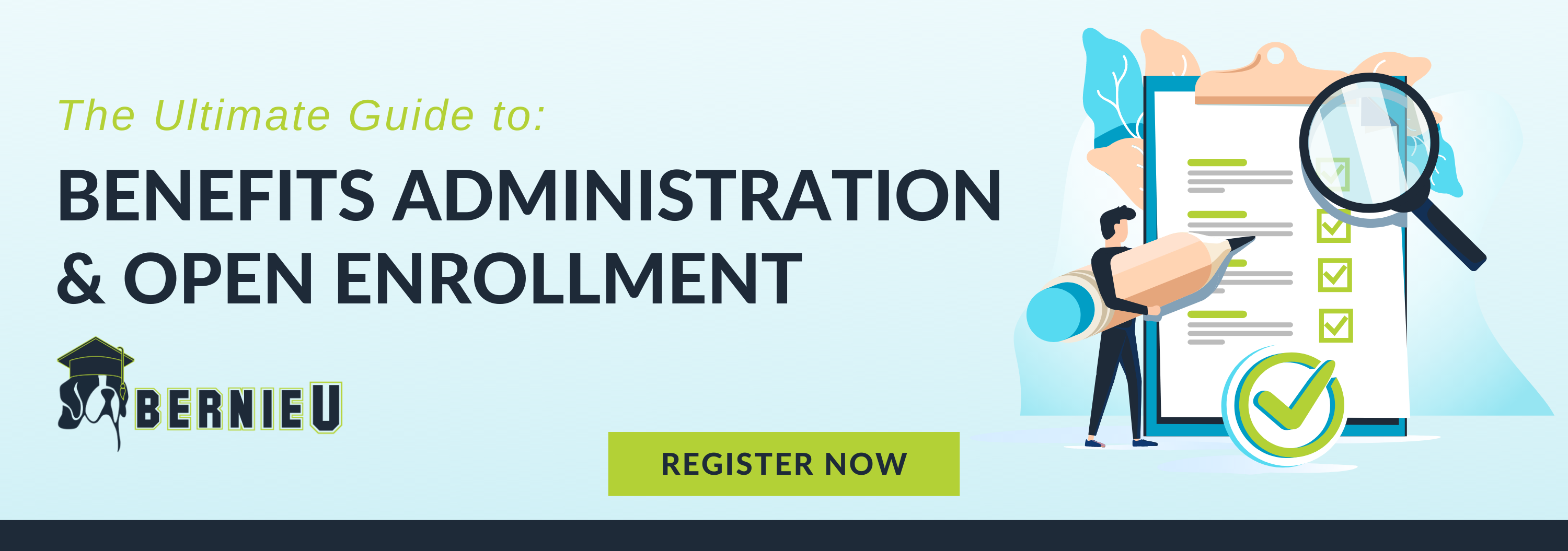
Written by
Aidan Farrish
Aidan is an aPHR-certified writer on the marketing team at BerniePortal. She writes about HR, healthcare, and benefits.
Updated for 2024: Employee Benefits Notice Requirements

HR pros know that compliance is crucial to their organization’s success. Although you may prefer to focus on more strategic objectives—such as recruitment, retention, or performance management—it should be a priority to comply with laws governing benefits administration. Otherwise, your organization’s bottom line could be eaten up by federal fines.
To simplify compliance, here’s what you need to know about benefits notice requirements for 2023.
What Are Employee Benefits Notice Requirements?
Each year, employers are subject to a variety of federal labor laws and regulations, requiring them to disclose particular benefits information to employees. In most situations, the Department of Labor (DOL) requires employers to post this information online or in a highly visible area of the workplace, ensuring that it’s easily accessible by all employees.
The DOL clarifies which regulations apply to which employers. For example, some regulations only apply to state and federal government employers rather than private employers while others only apply to employers of a certain size and not smaller ones.
Health and Retirement Plan Benefits Notices Required by ERISA and the ACA
There are several federal laws governing benefits notice requirements, but the most expansive are:
- the Employee Retirement Income Security Act (ERISA), which establishes minimum standards for most retirement and healthcare plans in the private sector
- the Affordable Care Act (ACA), which requires all employers with 50 or more full-time or full-time equivalent employees—called applicable large employers (ALEs)—to offer minimum essential coverage (MEC) for healthcare to all full-time employees.
Unlike ACA requirements, ERISA applies to employers of all sizes who offer qualified health and retirement plans. Noncompliance can be costly. Plans that do not fall under ERISA primarily include pensions or other plans provided by federal, state, or local governments and churches.
Any time employees may change or elect benefits—such as during open enrollment, while onboarding, or after a qualifying life event—employers must provide a Summary of Benefits and Coverage (SBC) and a Uniform Glossary. The purpose of this document is to provide enough information for employees to choose which plan would be best for them.
The SBC should be an overview of the employer-sponsored plan that is also easy for employees to understand. The Uniform Glossary should be included with the SBC and explains common terms used throughout the document.
Similarly, once an employee has enrolled in a plan, ERISA also requires they receive a Summary Plan Description (SPD) along with a Patient Protection Notice. According to the DOL, qualified plan administrators must provide participants with an SPD—which explains “what the plan provides and how it operates”—within 90 days of coverage and within 30 days of a request.
Additionally, ALEs must notify new hires with information about:
- the Healthcare.gov Marketplace, including a description of Marketplace services and how employees can learn more.
- Premium Tax Credit Eligibility, for which employees may be eligible under certain circumstances, including if the employer-provided MEC doesn’t cover at least 60% of total allowed cost of benefits that can be expected to be incurred under the plan.
- the Potential Loss of Employer Contribution, meaning employees should be aware that employers might not contribute to a health plan purchased through the Marketplace.
The ACA also requires ALEs to distribute Form 1095-C to all full-time employees by March 2 of each year.
Health Plan Benefits Notices Required by COBRA
The Consolidated Omnibus Budget Reconciliation Act (COBRA) protects employees and their dependents from losing their group health plan benefits when their coverage would otherwise end—such as voluntary or involuntary termination, reduction of hours, or other qualifying life events.
COBRA requires employers who sponsor a group health plan and have 20 or more full-time employees to offer a continuation of coverage to qualified beneficiaries for a limited period of time.
Those employers must inform employees of their COBRA rights by providing them with a general notice within the first 90 days of group health plan coverage. Often, the general notice is simply included in the plan’s SPD.
If an employee experiences a qualifying event, the employer must notify the plan administrator within 30 days of the event. Then, the plan administrator must provide qualified beneficiaries with an election notice within 14 days of receiving notice from the employer.
The DOL provides model COBRA notices for employers.
Health Plan Privacy Notices Required by HIPAA
The Health Insurance Portability and Accountability Act (HIPAA) requires covered entities to protect the privacy of individually identifiable health information. When an employee enrolls in a health plan, employers must notify them of the privacy practices of the plan, including how their personal medical information will be used.
Additionally, HIPAA breaches must be reported to the Secretary of Health and Human Services and to affected individuals. Individuals must be notified in writing within 60 days of the breach’s discovery and must include:
- a brief description of the breach
- a description of the kind of information involved
- how affected individuals can protect themselves
- what the covered entity is doing in response to the breach
Prescription Drug Benefits Notice Required by MMA
The Medicare Modernization Act (MMA) requires employers who sponsor health plans including prescription drug coverage to notify eligible policyholders whether or not their plan qualifies as creditable coverage. Creditable coverage refers to employer-sponsored prescription drug coverage that is at least as good as the subsidized Medicare Part D plan.
Even if an employer’s drug plan is not considered creditable, they must still disclose that information to Medicare-eligible employees.
This written notice may be delivered electronically or by mail and must be issued each year prior to Medicare’s enrollment period. CMS provides notice letter templates on its website. The annual deadline is October 15.
Leave Benefits Notices Required by FMLA
Under the Family and Medical Leave Act (FMLA), covered employers are required to offer 12 weeks of unpaid, job-protected leave to certain employees, whose group health benefits must also be maintained throughout.
A covered employer under FMLA is one with 50 or more employees in 20 or more workweeks in the current calendar year or in the preceding one. Eligible employees must have worked for the employer for at least 12 consecutive months and for at least 1250 hours in that 12-month period.
Covered employers must post a general FMLA notice in a highly visible location in the workplace. This FMLA poster can also be used to satisfy the requirement that employees receive notice upon hiring and in written leave guidance—which may be included in a Culture Guide or employee handbook.
Other Required Benefits Notices
The list above is hardly comprehensive. In addition to those already mentioned, HR should stay compliant with all federal notice requirements, including:
- CHIP Notice
- Grandfathered Plan Notice
- Newborns' and Mothers' Health Protection Act Notice
- Wellness Program Notice of Reasonable Alternatives
- Women's Health and Cancer Rights Act Notice
How to Simplify Benefits Notice Compliance
To streamline employee benefits notice compliance, employers should consider a human resources information system (HRIS) like BerniePortal. Within BerniePortal’s Compliance feature, notices can be hosted in one digital location, and HR can track signatures and send reminders.
BerniePortal allows HR pros to focus on more strategic roles and empowers employers to spend less time on administration—and more time building building a great place to work.
Additional Resources
You can stay informed, educated, and up-to-date with important HR topics using BerniePortal’s comprehensive resources:
- BerniePortal Blog—a one-stop-shop for HR industry news
- HR Glossary—featuring the most common HR terms, acronyms, and compliance
- HR Guides—essential pillars, covering an extensive list of comprehensive HR topics
- BernieU—free online HR courses, approved for SHRM and HRCI recertification credit
- HR Party of One—our popular YouTube series and podcast, covering emerging HR trends and enduring HR topics

Written by
Aidan Farrish
Aidan is an aPHR-certified writer on the marketing team at BerniePortal. She writes about HR, healthcare, and benefits.
Related Posts
We just wrapped up another phenomenal Weekdays with Bernie (WWB) Conference!
Employees are the heart and soul of an organization, and valuing their opinions can have...
HR parties of one already have an abundance of tasks to keep up with. From hiring to...
The talent search is no longer a skirmish or a battle. It’s a WAR! As a strategic HR...







Submit a Comment